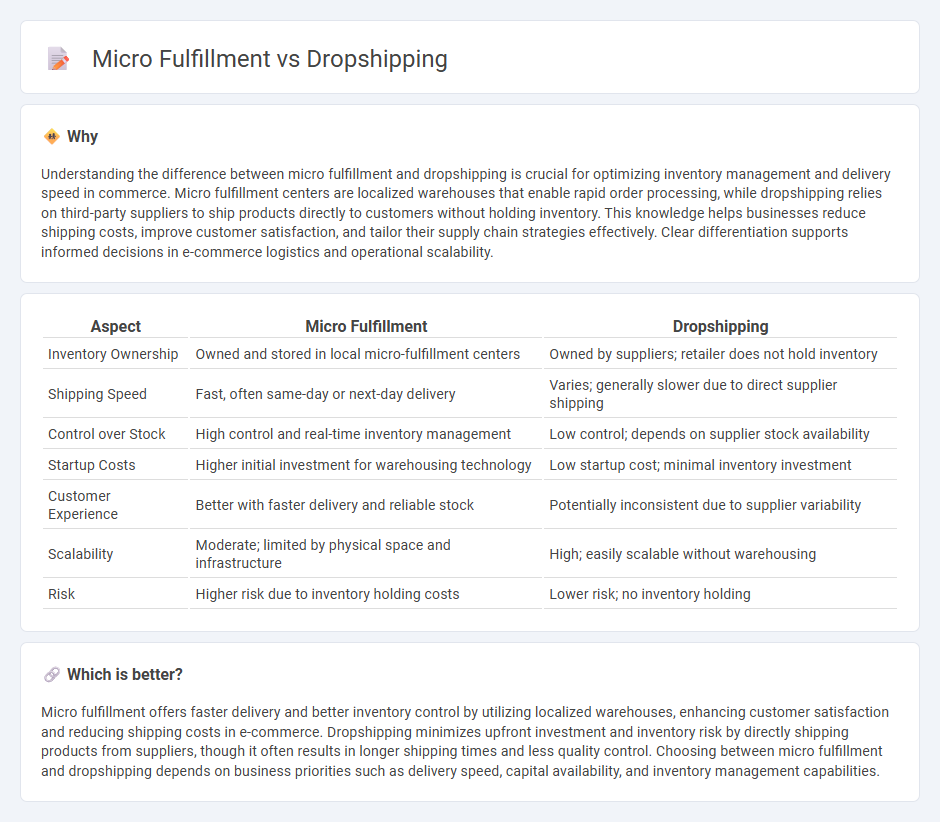
Micro fulfillment centers leverage localized warehouses and automation technology to rapidly process and ship orders, cutting delivery times and enhancing inventory control. Dropshipping eliminates the need for inventory storage by directly forwarding customer orders to suppliers for shipment, reducing upfront investment but often increasing delivery time and decreasing control over product quality. Explore how choosing between micro fulfillment and dropshipping can impact your e-commerce strategy and customer satisfaction.
Why it is important
Understanding the difference between micro fulfillment and dropshipping is crucial for optimizing inventory management and delivery speed in commerce. Micro fulfillment centers are localized warehouses that enable rapid order processing, while dropshipping relies on third-party suppliers to ship products directly to customers without holding inventory. This knowledge helps businesses reduce shipping costs, improve customer satisfaction, and tailor their supply chain strategies effectively. Clear differentiation supports informed decisions in e-commerce logistics and operational scalability.
Comparison Table
| Aspect | Micro Fulfillment | Dropshipping |
|---|---|---|
| Inventory Ownership | Owned and stored in local micro-fulfillment centers | Owned by suppliers; retailer does not hold inventory |
| Shipping Speed | Fast, often same-day or next-day delivery | Varies; generally slower due to direct supplier shipping |
| Control over Stock | High control and real-time inventory management | Low control; depends on supplier stock availability |
| Startup Costs | Higher initial investment for warehousing technology | Low startup cost; minimal inventory investment |
| Customer Experience | Better with faster delivery and reliable stock | Potentially inconsistent due to supplier variability |
| Scalability | Moderate; limited by physical space and infrastructure | High; easily scalable without warehousing |
| Risk | Higher risk due to inventory holding costs | Lower risk; no inventory holding |
Which is better?
Micro fulfillment offers faster delivery and better inventory control by utilizing localized warehouses, enhancing customer satisfaction and reducing shipping costs in e-commerce. Dropshipping minimizes upfront investment and inventory risk by directly shipping products from suppliers, though it often results in longer shipping times and less quality control. Choosing between micro fulfillment and dropshipping depends on business priorities such as delivery speed, capital availability, and inventory management capabilities.
Connection
Micro fulfillment centers enhance dropshipping efficiency by offering rapid inventory storage and streamlined order processing close to consumers, reducing shipping times and costs. Dropshipping benefits from micro fulfillment's localized inventory management, which bridges the gap between suppliers and end customers, enabling faster delivery and improved customer satisfaction. Integrating micro fulfillment with dropshipping optimizes supply chain agility and scalability in modern e-commerce operations.
Key Terms
Inventory Management
Dropshipping eliminates inventory holding by directly shipping products from suppliers to customers, reducing storage costs and risks of overstocking. Micro fulfillment centers maintain small, strategically located warehouses to quickly manage and ship orders, enhancing control over inventory and delivery speed. Explore more to understand how each model impacts fulfillment efficiency and customer satisfaction.
Order Fulfillment
Dropshipping relies on suppliers to directly ship products to customers without holding inventory, enabling low overhead but longer delivery times, while micro fulfillment employs localized warehouses closer to customers for faster order processing and reduced shipping costs. Micro fulfillment centers utilize automation and real-time inventory management, improving order accuracy and customer satisfaction in e-commerce operations. Explore the advantages of each model to optimize your business's order fulfillment strategy.
Shipping Speed
Micro fulfillment centers significantly enhance shipping speed by utilizing localized warehouses and automated technology, enabling delivery within hours or same-day to customers. Dropshipping relies on third-party suppliers and longer shipping routes, often resulting in extended delivery times ranging from several days to weeks. Explore the benefits of micro fulfillment for faster order delivery and improved customer satisfaction.
Source and External Links
What Is Dropshipping and How Does It Work? (2025) - Shopify - Dropshipping is a business model where an online store sells products that are shipped directly to customers by a supplier or manufacturer, removing the need for inventory management.
What Is Dropshipping and How Does It Work? - Wix.com - Dropshipping allows retailers to sell products without stocking inventory by forwarding customer orders to a third-party supplier who handles fulfillment and shipping.
Drop shipping - Wikipedia - Drop shipping is a form of retail where the seller takes customer orders without holding stock and transfers orders to a manufacturer, wholesaler, or other supplier who ships directly to customers, minimizing overhead costs but with less control over inventory and shipping.
 dowidth.com
dowidth.com